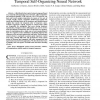Free Online Productivity Tools
i2Speak
i2Symbol
i2OCR
iTex2Img
iWeb2Print
iWeb2Shot
i2Type
iPdf2Split
iPdf2Merge
i2Bopomofo
i2Arabic
i2Style
i2Image
i2PDF
iLatex2Rtf
Sci2ools
TSMC
2002
2002
A distributed robotic control system based on a temporal self-organizing neural network
A distributed robot control system is proposed based on a temporal self-organizing neural network, called competitive and temporal Hebbian (CTH) network. The CTH network can learn and recall complex trajectories by means of two sets of synaptic weights, namely, competitive feedforward weights that encode the individual states of the trajectory and Hebbian lateral weights that encode the temporal order of trajectory states. Complex trajectories contain repeated or shared states which are responsible for ambiguities that occur during trajectory reproduction. Temporal context information are used to resolve such uncertainties. Furthermore, the CTH network saves memory space by maintaining only a single copy of each repeated/shared state of a trajectory and a redundancy mechanism improves the robustness of the network against noise and faults. The distributed control scheme is evaluated in point-to-point trajectory control tasks using a PUMA 560 robot. The performance of the control system...
| Added | 23 Dec 2010 |
| Updated | 23 Dec 2010 |
| Type | Journal |
| Year | 2002 |
| Where | TSMC |
| Authors | Guilherme De A. Barreto, Aluizio F. R. Araújo, C. Dücker, Helge Ritter |
Comments (0)

